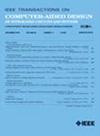Reconfigurable Radiation-Hardened SRAM Cell Design for Different Radiation Environments
IF 2.9
3区 计算机科学
Q2 COMPUTER SCIENCE, HARDWARE & ARCHITECTURE
IEEE Transactions on Computer-Aided Design of Integrated Circuits and Systems
Pub Date : 2025-02-11
DOI:10.1109/TCAD.2025.3541010
引用次数: 0
Abstract
This article proposes a novel and effective 14-transistors (14T) reconfigurable radiation-hardened static-random access-memory cell design under the SMIC 65-nm process, featuring a unique memory reconfigurability architecture with two operation modes, namely the high reliability (HR) mode and the triple-time memory (TTM) mode for meeting different radiation environmental requirements. The proposed HR mode provides strong protection of the memory arrays in harsh radiation environments. Compared with the traditional triple modular redundancy (TMR) structure, the proposed HR mode reduces area overhead by 30%, delay by 37%, and power consumption by 16%. The TTM mode uses the enable (EN) circuit to expand the capacity threefold in less harsh radiation environments, avoiding the area wastage caused by the traditional TMR structure. By implementing the two innovative operation modes, the proposed design overcomes the limitations of the traditional TMR structure, reducing area overhead while retaining the radiation hardening capability. In addition, this article presents a mode-switching mechanism composed of a detection circuit and an EN circuit. The detection circuit can detect errors in the reconfigurable architecture. With the proposed mode-switching mechanism, two operation modes can switch in response to different radiation environments. Besides, to ensure the normal operations of the TTM mode in radiation environments, the proposed 14T cell serves as a bitcell in the memory reconfigurable architecture. Compared with typical existing designs, such as radiation-hardened based design, writability enhanced, and dual interlocked storage cell (DICE) cells, the proposed 14T cell design has better delay, critical charge, and higher hold static noise margin.针对不同辐射环境的可重构辐射硬化SRAM单元设计
本文在中芯国际65纳米工艺下提出了一种新颖有效的14晶体管(14T)可重构辐射硬化静态随机存取存储单元设计,具有独特的存储器可重构架构,具有高可靠性(HR)模式和三倍存储(TTM)模式两种工作模式,可满足不同的辐射环境要求。提出的HR模式可以在恶劣的辐射环境中对存储阵列提供强有力的保护。与传统的三模冗余(TMR)结构相比,提出的HR模式减少了30%的面积开销,减少了37%的延迟,减少了16%的功耗。TTM模式采用使能(EN)电路,在辐射不太恶劣的环境下将容量扩展三倍,避免了传统TMR结构造成的面积浪费。通过实施两种创新的操作模式,所提出的设计克服了传统TMR结构的局限性,减少了面积开销,同时保留了辐射硬化能力。此外,本文还提出了一种由检测电路和EN电路组成的模式切换机制。该检测电路可以检测可重构结构中的错误。利用所提出的模式切换机制,两种工作模式可以根据不同的辐射环境进行切换。此外,为了保证TTM模式在辐射环境下的正常工作,本文提出的14T cell作为内存可重构架构中的位cell。与现有的典型设计(如基于辐射硬化的设计、增强可写性的设计和双联锁存储单元(DICE)电池)相比,本文提出的14T电池设计具有更好的延迟、临界电荷和更高的保持静态噪声裕度。
本文章由计算机程序翻译,如有差异,请以英文原文为准。
求助全文
约1分钟内获得全文
求助全文
来源期刊
CiteScore
5.60
自引率
13.80%
发文量
500
审稿时长
7 months
期刊介绍:
The purpose of this Transactions is to publish papers of interest to individuals in the area of computer-aided design of integrated circuits and systems composed of analog, digital, mixed-signal, optical, or microwave components. The aids include methods, models, algorithms, and man-machine interfaces for system-level, physical and logical design including: planning, synthesis, partitioning, modeling, simulation, layout, verification, testing, hardware-software co-design and documentation of integrated circuit and system designs of all complexities. Design tools and techniques for evaluating and designing integrated circuits and systems for metrics such as performance, power, reliability, testability, and security are a focus.

 求助内容:
求助内容: 应助结果提醒方式:
应助结果提醒方式:


